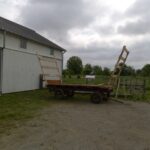By Gabe Ross, Farm Manager

Every Summer for thousands of years the same task has been happening on farms all over the world. The Roman farmer Columella wrote of hay making in the first century A.D., but he certainly wasn’t the first to do it. It has been passed down from generation to generation changing greatly in some ways and not so much in others. Making hay was a great advancement that allowed livestock to have feed all winter, even in cold climates where there were no pastures in those dormant times.
Early hay was mowed with scythes or sickles and put up loose in stacks, or later in barns. Around the mid-19th century the sickle bar mower was invented and made the cutting of hay quicker and easier. The steel hay rake came around the same time and allowed farmers to flip the hay for faster and more complete drying. The stationary baler came along in the late 19th century and quickly tractor-pulled balers that made small bales became available. At this point hay became a commodity and could be used on the farm or sold, loose hay was too hard to transport over long distances. Fast forward to today and you will see large bales, round bales, square bales, and bales that are wrapped in white plastic to make haylage, which is like silage but using hay instead of corn.
Hay was put up loose in barns regularly well into the 20th century in the US and still is in some places, including here at Gallant Farm. One “modern convenience”, for the 1930s anyway, we’ve added this year is a wagon with rubber tires. Wagons like this one often started out as steel wheeled wagons and later had the steel tire cut off and the spokes welded to an automotive rim. The pneumatic tire sure made a smoother ride in the field and are less likely to tear up the road and cause soil compaction. I added some hay lades to the front and back so the hay can be stacked higher and more can be hauled per load. This wagon also has woods sides, front and back that can be added to use it for harvesting ear corn.
Wish us luck with the weather and hopefully we’ll see you all on the other side of the windrow.







